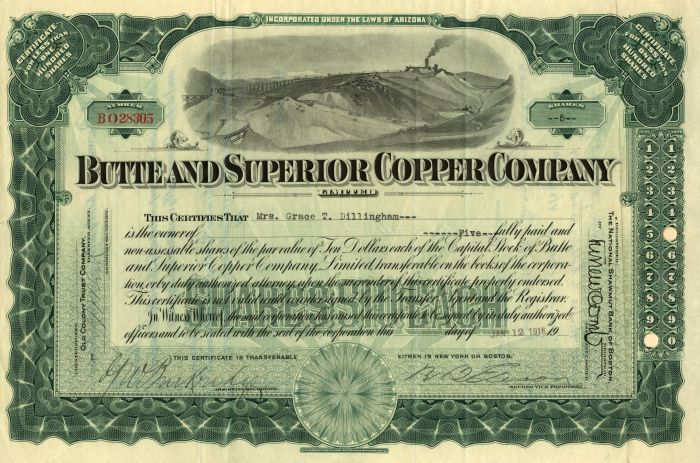Butte and Superior Copper Co. - Stock Certificate
Inv# MS2382 Stock
Exceptional. Only 1 Found.
Copper mining in the United States has been a major industry since the rise of the northern Michigan copper district in the 1840s. In 2017 the United States produced 1.27 million metric tonnes of copper, worth $8 billion, making it the world's fourth largest copper producer, after Chile, China, and Peru. Copper was produced from 23 mines in the US. Top copper producing states in 2014 were (in descending order) Arizona, Utah, New Mexico, Nevada, and Montana. Minor production also came from Idaho, and Missouri. As of 2014, the US had 45 million tonnes of known remaining reserves of copper, the fifth largest known copper reserves in the world, after Chile, Australia, Peru, and Mexico.
Copper in the US is used mainly in construction (43%) and electric equipment (19%). In 2014, the nation produced 69% of the copper it used, relying on imports from Chile, Canada, Peru, and Mexico for the remaining 31%.
Copper mining activity increased in the early 2000s because of increased price: the price increased from an average of $0.76 per pound for the year 2002, to $3.02 per pound for 2007.
A number of byproducts are recovered from American copper mining. In 2013, American copper mining produced 28,500 metric tons of molybdenum, worth about $700–$800 million, which was 47% of total US production. In 2014, copper mining produced about 15 metric tons of gold, worth $600 million, which represented 7% of US gold production. Other byproducts of the copper extraction process included silver, and minor amounts of rhenium and platinum-group metals. Sulfuric acid is recovered at copper smelters.
In geomorphology, a butte (/bjuːt/) is an isolated hill with steep, often vertical sides and a small, relatively flat top; buttes are smaller landforms than mesas, plateaus, and tablelands. The word butte comes from a French word meaning knoll (but of any size); its use is prevalent in the Western United States, including the southwest where mesa (Spanish for "table") is used for the larger landform. Due to their distinctive shapes, buttes are frequently landmarks in plains and mountainous areas. To differentiate the two landforms, geographers use the rule of thumb that a mesa has a top that is wider than its height, while a butte has a top that is narrower than its height.
Superior (Western Apache: Yooʼ Łigai) is a town in Pinal County, Arizona, United States. According to the 2010 census, the population of the town is 2,837. Superior was founded as a mining town for the Silver Queen and the later Magma mines.
During the 1870s, at the height of the American Indian Wars, a company of Apache horsemen were ambushed by US cavalry. After losing 50 men, the Apache retreated up the mountain later named Apache Leap. Accepting defeat, the remaining Apache leapt to their death rather than being captured by the US cavalry.
Superior was originally called Queen, then Hastings, and under the latter name was platted in 1900.
Queen had a population of around 100 circa 1880. There was a general store, 2 hotels, numerous saloons, and a post office. The Queen post office closed Sept. 15, 1881.
The Superior townsite was laid out in 1902, and named after the Lake Superior and Arizona Copper Company (LS&A). The Superior post office opened on December 29, 1902.
The origin of Magma Mine began on March 22, 1875, when Charles G. Mason and four companions found native silver, and staked the Silver King claim. On March 29, 1875, the Silver Queen (Magma) vein was staked, and the Silver Queen Mining Company was organized in 1880. However, with the depletion of silver, the Silver Queen shut down in 1893, and the Silver King in 1896. In 1910, William Boyce Thompson and George Gunn bought the Silver Queen mine, and organized the Magma Copper Company. A 300-ton-per-day concentrator was built in 1914. In 1915, a narrow-gauge railway connected Superior with the Southern Pacific Railroad, which was converted to standard gauge in 1923. A smelter was built in 1924.
After 71 years of production, the Magma mine closed in August 1982 due to high operating costs and declining copper prices. Operations resumed in September 1990, but the mine closed again on June 28, 1996. During its 86-year life (1910–1996). the Magma mine produced approximately 27.6 million short tons of ore averaging about 4.9% copper, recovering 1,299,718 short tons of copper, 36,550 short tons of zinc, approximately 686,000 ounces of gold and 34.3 million ounces of silver.
The old Magma No. 9 shaft atop Apache Leap is being used to explore the huge Resolution Copper deposit below.
A stock certificate is issued by businesses, usually companies. A stock is part of the permanent finance of a business. Normally, they are never repaid, and the investor can recover his/her money only by selling to another investor. Most stocks, or also called shares, earn dividends, at the business's discretion, depending on how well it has traded. A stockholder or shareholder is a part-owner of the business that issued the stock certificates.









Ebay ID: labarre_galleries